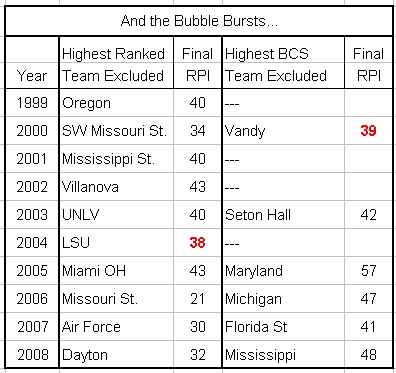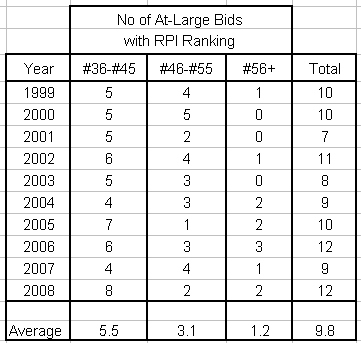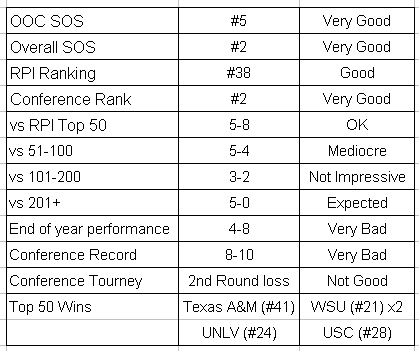There have been some interesting comments made about the Bubble this year that need to be saved for future reference. Plus Alpha/RAWFS has fixed it so I can use tables again….so here goes a little supplemental information about this year’s marginal selections/snubs:
Let’s start with some tables that go pretty well with a commentary from last week:
My tables were updated from last year’s entry so the parsing is slightly different from Jeff’s…but the tables do a good job at highlighting the key points from that commentary. The bottom line is that RPI ranking is an easy first cut at where teams from BCS conferences stand with the NCAAT Selection Committee.
I am not going to repeat stuff from last year or last week…so check out both entries if you are interested in taking a closer look at Clearing the Bubble and landing in the NCAAT.
Andy Katz included some comments from this year’s NCAAT Selection Committee Chairman, Tom O’Connor (AD at George Mason), that deserve a little closer look.
Arizona State being out: “The reality check was that their strength of schedule was extremely way up there. If ASU had been selected it would have been the highest RPI ever put in the NCAA [as an at-large]. They were also 2-7 vs. the top of the Pac-10. We were cognizant that they beat Arizona twice, but in the final analysis we didn’t feel they were one of the 34 best at-large teams.”
There are a number of different things about ASU that bear further discussion. Let’s break down several interesting points from this quote.
1) I have posted the following formula several straight years and it is nice to see that it was validated again this year:
Weak OOC Schedule +
Marginal Conference Performance +
Poor Conference Tournament Performance =
NIT
I watched it happen to UVA (2000), VT (2005), and FSU (2006), so I was not at all surprised when it happened this year to ASU. ASU had some nice wins this year…but not enough to overcome some significant negatives. Dick Vitale (like thousands from the MSM to message boards) tries to oversimplify the Selection Process by picking one criteria and deciding that it is the only one that matters. But if you really want simple, here it is: “Don’t schedule an embarassingly easy OOC schedule.”
2) Let’s take a closer look at one sentence from the ASU comments: “They were only 2-7 versus the top of the PAC-10.†If that was really a criterion, then how did State make the NCAAT in 2002 and 2003? You can really only reach one of two possible conclusions:
– The Selection Committee is made up of idiots that make up new rules every year. OR
– This disparity (NCSU vs ASU) demonstrates the importance of the conference tournament games for teams with marginal credentials.
3) One of the things that frequently comes up when dissecting the Committee decisions is that Team X beat Team Y, but Team Y got an at-large bid and Team X didn’t. Just add ASU vs UoA to the long list of examples that demonstrates the fact that the NCAAT Selection Committee doesn’t look at head-to-head results when selecting the at-large bids. It’s simply too complicated to be settled by some simplistic tie-breaking procedure. (Besides, I doubt that ASU was the last team out this year.)
In direct contrast with ASU, Kentucky and Arizona had much harder schedules and received at-large bids. Let’s look at Arizona first. Here are some key stats:
When I combine conference record (8-10), end of year performance (4-8), and conference tourney results….I get NIT. The guys at the Dance Card have a much more rigorous analysis technique and they concluded that Arizona would barely clear the Bubble. Here’s what the Selection Chair had to say:
Arizona in: “The Wildcats were 16-6 with Nic Wise and Jerryd Bayless, and their strength of schedule [was high]. When they weren’t in the lineup they were a different team.”
IMO (humble but accurate), the injury excuse is a can of worms that the Selection Committee should not have opened…especially with Arizona’s poor play over the last six weeks of the season. It would be one thing to “forgive†defeats in the middle of a season if the team then finished strong. But when a team struggles all the way through the conference tournament, the SOS and injury arguments seem weak to me.
Now for Kentucky…I would post a quote from the Selection Chair, but the snippets that Katz put in make little/no sense. 12-4 in the SEC, end of year run of 11-3, wins over Tennessee (#2) and Vanderbilt (#12), all make Kentucky an easy pick for me. I am not saying that Kentucky didn’t have some warts…but they had a lot of good stuff in there as well.
The important thing to take away from Arizona St, Arizona, and Kentucky is that OOC SOS clearly matters to the Selection Committee. Arizona also represents an extreme example of how much the Selection Committee is willing to overlook for teams who do play difficult OOC schedules. The Selection Committee has established some fairly clear rules for those teams that insist on playing weak OOC schedules….so ignore these lessons at your own risk.
VT (out), Ohio State (out), and Oregon (in) are a few of the other BCS schools that show up on various lists. There’s also a comment that road victories against top teams are important (not exactly late-breaking news). I think that we’ve beaten VT to death and I suspect that there is not much interest in either of the other two….so let’s move on to the Mid-Major Mess.
Last year, I threw up my hands and just refused to look at the mid-majors and gave several glaring examples why I thought that the Selection Committee’s standards were impossible to discover. But let’s just write off the worst case examples as internal politics on that year’s Selection Committee and list a few things that appear to come into play when evaluating Mid-Majors.
– You need more top-50 wins than just a couple from within your own conference (Illinois State, 2008)…especially when they both come against a team ranked #46.
– You need to finish near the top of your conference, nearly regardless of who you might beat in Nov/Dec. (Dayton 2008)
– There is likely a “glass ceiling†that will limit how many teams can get into the NCAAT, almost regardless of records. (MVC, 2006)
– Because of the glass ceiling, you have to perform in your conference tournament when there are too many teams from your conference contending for at-large bids (Missouri St and Creighton 2006)
These mid-major observations are not based on as much research as I typically put into other analyses that I defend to the death. These are just meant as starting points for additional discussion. If I get a little help fleshing these out…we might even try to put up a prediction entry for mid-majors with high RPI rankings next year.
CONCLUSION
When someone from the Selection Committee says something stupid, we are left with the following choices:
– Wonder if he is really that stupid
– Wonder if he thinks that we are that stupid
– Wonder if he is scrambling for justification for a decision (good or bad)
In all seriousness, I am more interested in what the Selection Committee does than what they say in interviews. It’s not that I disregard what they say, it’s just that they are too close to career politicians for my taste. You know how to tell if a politician is lying…don’t you?






